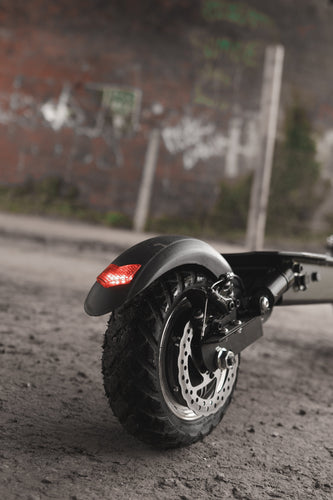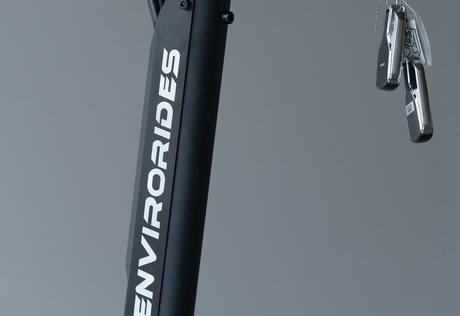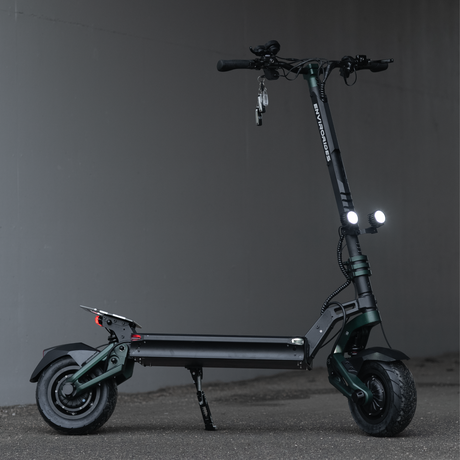Electric scooters have become an integral part of modern urban transportation, offering a convenient and eco-friendly alternative. Among the various components contributing to electric scooter's functionality and safety, the brake system plays a crucial role. In this comprehensive guide, we will explore the different types of electric scooter brakes, address common questions about their usage and maintenance, and provide insights into ensuring a safe and efficient riding experience.
The different types of electric scooter brakes
Electric scooters, being versatile and popular urban commuting devices, come equipped with various braking systems tailored to meet diverse rider preferences and requirements. Understanding the nuances of these braking mechanisms is essential for riders seeking optimal control and safety during their journeys. Here, we explore the key types of electric scooter brakes, each presenting unique features and considerations.
Mechanical Brake Systems
Drum Brakes and how they work
Simplicity and durability. While not as widely used as disc brakes, drum brakes have their own set of advantages. Drum brakes stand out as the prevailing brake variant found in electric scooters. Typically crafted from materials such as steel, aluminium, or stainless steel, the brake shoe is a crucial component of this system. The entire brake assembly is commonly enclosed over the front or rear wheel.
The functionality of drum brakes involves an inner drum in rotational alignment with a wheel situated externally. Upon engaging the brake lever, a rod is activated, compelling the inner drum to press against the outer drum. The resulting friction generates heat, effectively bringing the electric scooter to a halt.
Disc Brakes and how they work
Disc brakes for electric scooters function by engaging a small metal disc connected to the wheel, exerting pressure against the brake pads. These pads then act on the rotating rotor, slowing down the electric scooter's movement.
Many riders opt for disc brakes, favouring them over alternatives like drum or electric brakes due to their robust stopping power. Mechanical disc brakes, in particular, stand out as highly effective in bringing the scooter to a secure stop, albeit at a higher cost.
In contrast, hydraulic disc brakes utilise fluid instead of air for operation. This design enhances efficiency and simplifies maintenance compared to their mechanical counterparts. However, it's worth noting that hydraulic disc brakes come with a higher price tag and may be prone to leakage without proper maintenance.
Foot brakes and how they work?
Foot brakes serve as a straightforward secondary braking option on electric scooters, providing a sense of security rather than robust stopping power.
Engaging a foot brake involves pressing down on a hinged fender positioned above the rear tire, generating friction that gradually decelerates the scooter. Although lightweight and easy to maintain, foot brakes exhibit reduced effectiveness, particularly in wet conditions, leading to decreased reliability.
Despite their limitations, riders appreciate foot brakes for their simplicity and durability, demanding minimal upkeep aside from periodic rear tire replacements. However, their drawback becomes apparent when compared to the superior performance of more efficient finger-operated brakes.
Electronic Braking Systems
Electronic Brakes and how they work
Electronic brakes represent a cutting-edge braking system employed in some modern electric scooters. Unlike traditional mechanical systems, electronic brakes utilise sensors and electronic signals to modulate and control the braking force.
Electronic brakes function by interpreting signals from sensors, and detecting the rider's braking intentions. These signals then trigger the electric brake system, adjusting the braking force accordingly. The absence of physical contact between brake components reduces wear and tear, contributing to a longer lifespan for the braking system.
Regenerative Brakes how they work
Regenerative brakes in electric scooters capture and convert kinetic energy into electrical energy during braking, subsequently recharging the scooter's battery. This innovative system extends the scooter's range, promotes eco-friendly operation, and minimises wear on brake components. Often integrated with traditional brakes, regenerative braking underscores sustainability while requiring proper maintenance for optimal performance and system longevity.
So which electric scooter brakes are the best?
Determining the best electric scooter brakes depends on individual preferences, usage patterns, and priorities. Each type of brake system—mechanical, electronic, disc, and drum has its own set of advantages and considerations. Let's explore the characteristics of each to help you make an informed decision:
If you opt for a mechanical braking system, you'll need to choose between disc and drum brakes. Drum brakes, while simpler, are generally less effective in stopping the vehicle compared to disc brakes. This is because drum brakes have limitations in dissipating heat and providing sufficient surface area for contact with other surfaces, unlike their disc counterparts.
Electric scooter disc brakes stand out for their robust braking power, making them highly effective. However, they tend to be pricier than drum brakes and demand more maintenance.
On the other hand, an electronic brake system has distinct advantages. It adds minimal weight to the vehicle and requires no maintenance, rendering it the most reliable braking option available for electric scooters.
Ultimately, the "best" electric scooter brakes depend on your specific needs. If you prioritise strong braking power and efficiency, disc brakes might be ideal. For simplicity and durability, drum brakes could be a suitable choice. If the minimal weight and low maintenance are crucial, an electronic brake system may be the most favourable. It's recommended to test different brake systems and consider factors like cost, maintenance, and personal preferences to determine which option aligns best with your electric scooter usage.
Should you use front or rear brakes on an electric scooter?
When riding an electric scooter, it is generally recommended to use both the front and rear brakes simultaneously for optimal stopping power and stability. Applying both brakes ensures a more balanced and controlled deceleration, minimising the risk of skidding or loss of control. By using a combination of front and rear brakes, riders can effectively distribute braking forces, enhancing overall safety and stopping efficiency.
The answer to whether you should use the front or rear brakes on an electric scooter depends on your preferences and priorities regarding the braking system. Electric scooters operate by generating power to propel forward, and when it comes to halting quickly, the application of the front brake is commonly favoured.
How to tighten electric scooter breaks?
Tightening electric scooter brakes is a simple process that you can perform at home. Here's a step-by-step guide to help you tighten the brakes:
Tools Needed:
- Allen wrench or screwdriver (size may vary depending on your scooter model)
- Adjustable wrench (if applicable)
- Brake adjustment knob (if your scooter has one)
Procedure:
- Locate the Brake Adjuster: Identify the brake adjustment mechanism on your electric scooter. This is often a knob or screw that allows you to adjust the brake tension.
- Check the Brake Cable: Inspect the brake cable for any signs of wear or damage. If the cable is damaged, it may need to be replaced.
Loosen the Brake Cable:
- Use the appropriate tool to loosen the brake cable if it's too tight. Be cautious not to loosen it excessively; you want to achieve a balance between tightness and responsiveness.
Adjust the Brake Adjustment Knob:
- If your scooter has a brake adjustment knob, turn it clockwise to tighten the brakes. Turn it in small increments, testing the brakes after each adjustment.
Inspect Brake Pads:
- Check the brake pads for wear. If they are significantly worn down, consider replacing them.
Align the Brake Pads:
- Ensure that the brake pads are properly aligned with the wheel rims. Misalignment can cause uneven braking and premature wear.
- After making adjustments, take your scooter for a test ride in a safe area. Gradually apply the brakes to ensure they engage smoothly and bring the scooter to a controlled stop.
Fine-Tune as Needed:
- If the brakes are still too loose or too tight, repeat the adjustment process until you achieve the desired tightness.
Remember to refer to your scooter's user manual for specific instructions related to your scooter model. If you're unsure or uncomfortable making adjustments, it's recommended to seek assistance from a professional or your scooter's manufacturer. Properly functioning brakes are crucial for your safety, so regular maintenance and adjustments are essential.
How Often Do Brakes Need to Be Replaced in an Electric Scooter?
It is generally recommended to replace the brake pads of an electric scooter every 250-300 kilometres or as soon as signs of wear become noticeable. This frequency may vary based on factors such as how often the brakes are applied and the type of brakes your scooter uses. Disc brakes typically need replacement every 300 to 900 kilometres, but this depends on usage patterns, and it's advisable to adjust brake pads every 6 to 8 months for optimal performance.
How to replace electric scooter brake pads
Replacing electric scooter brake pads is a relatively straightforward process that can be done by the rider. If brake pads are completely worn out or if you notice a decrease in braking power, it's recommended to replace them promptly.
The lifespan of brakes on electric scooters is influenced by factors like usage frequency, and brakes can generally last between 200 to 600 miles, depending on usage patterns.
Replacing electric scooter brake pads is a relatively straightforward process. Here's a general guide to help you replace the brake pads on your electric scooter:
Materials Needed:
- New brake pads compatible with your electric scooter model.
- Allen wrench or screwdriver (depending on your scooter's brake system
Procedure:
- Safety First: Ensure the scooter is powered off and on a stable surface.
If applicable, engage the scooter's kickstand to prevent it from rolling.
Identify Brake Type:
- Determine whether your electric scooter has disc brakes or drum brakes. The replacement process may vary based on the brake type.
Remove the Wheel:
For scooters with disc brakes: Use an Allen wrench to loosen and remove the bolts securing the calliper to the wheel. Slide the calliper off the disc.
For scooters with drum brakes: Remove the wheel cover to access the drum brake assembly.
Remove Old Brake Pads:
- Disc brakes: Slide the old brake pads out from the calliper.
- Drum brakes: Locate the brake shoes inside the drum and remove any retaining clips or springs holding them in place.
Install New Brake Pads:
- Insert the new brake pads into the calliper for disc brakes, ensuring they align correctly.
- For drum brakes, position the new brake shoes in the drum and secure them with any clips or springs.
Reassemble:
- For disc brakes: Slide the calliper back onto the disc and secure it with the bolts. Ensure the brake pads are properly aligned with the disc.
- For drum brakes: Reattach the wheel cover.
Adjustment (if needed):
- Check the brake cable tension. It should be snug but not overly tight. Adjust as necessary.
- Test the brakes by squeezing the brake lever or engaging the brake mechanism. Ensure the brakes engage smoothly.
Final Check:
- Spin the wheel to ensure there is no rubbing or resistance.
- Test the brakes at low speed to ensure proper function.
Repeat for the Other Wheel (if applicable):
If your electric scooter has brakes on both wheels, repeat the process for the other side.
Always refer to your scooter's user manual for specific instructions related to your model, as brake systems can vary. If you're uncertain about the process or confused with the steps then you would be happy to know that here at Envirorides we have a brake pad replacement service available.
FAQS
Do electric scooters brake in the rain?
Electric scooters can experience reduced braking performance in rainy conditions. Wet surfaces can affect the friction between the brake components and the wheels, leading to longer stopping distances and potentially diminished braking efficiency. The type of brakes on the scooter also plays a role in how they perform in wet conditions.- Disc Brakes: Electric scooters often use disc brakes, and these can be more effective than drum brakes in wet conditions. However, water on the disc surface can still lead to a delay in braking response.
- Drum Brakes: Scooters equipped with drum brakes may experience a more noticeable reduction in braking effectiveness in the rain. Water can get inside the drum, impacting the friction between the brake shoes and the drum.
To enhance safety when riding in wet conditions, riders should exercise extra caution, maintain a reduced speed, and increase their following distance from other vehicles. Additionally, it's advisable to test the brakes gently after riding through wet areas to ensure they are functioning properly.



